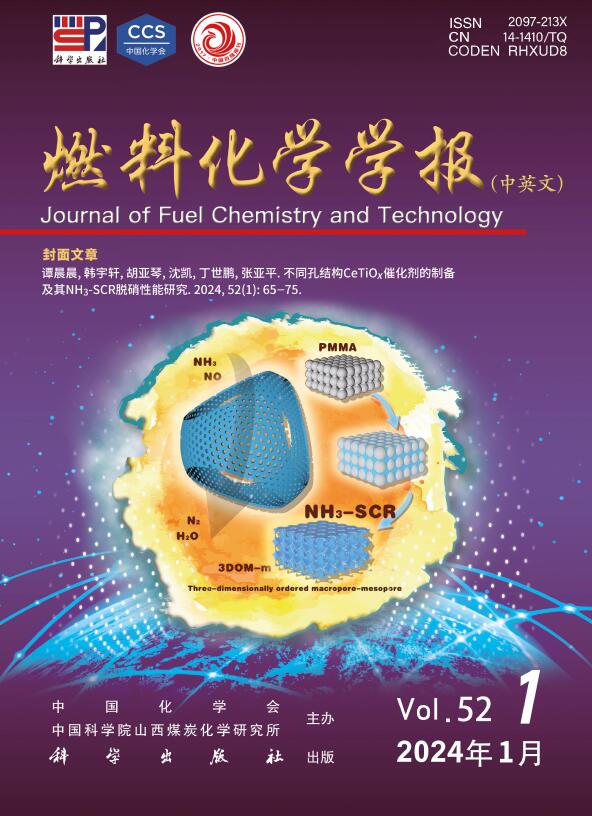Solution loss behavior of cokes and its kinetics under hydrogen-enriched atmosphere
Q3 Energy
引用次数: 0
Abstract
Hydrogen-enriched ironmaking presents a promising approach to mitigate coke consumption and carbon emission in blast furnace (BF) operations. This work investigated the relationship between the structural features of cokes and their reactivity towards solution loss (SL), especially under hydrogen-enriched atmospheres. Six cokes were characterized, and their SL behaviors were examined under varying atmospheres to elucidate the effects of hydrogen enrichment. The results indicate that an increase in fixed carbon content leads to a decrease in the coke reactivity index (CRI) and an increase in coke strength after reaction (CSR), in the CO2 atmosphere, the CSR of coke increases from 35.76%−62.83%, while in the 90CO2/10H2 atmosphere, the CSR of coke increases from 65.67%−84.09%. There is a good linear relationship between CRI and microcrystalline structure parameters of coke. Cokes with larger crystalline size, lower amorphous content, and smaller optical texture index (OTI) values show enhanced resistance to degradation and maintain structural integrity in BF. Kinetic analysis performed with the shifted-modified-random pore model (S-MRPM) reveals that alterations in pore structure and intrinsic mineral composition significantly influence the reaction rate. The introduction of a small amount of water vapor raises SL rates, whereas a minor addition of hydrogen (<10%) decelerates SL due to its incomplete conversion to water vapor and the reduced partial pressure of the gasifying agent. Thermodynamic calculations also indicate that the introduced hydrogen does not convert into the same fraction of water vapor. The shift from chemical reaction control to gas diffusion control as the rate-determining step with rising temperatures during SL process was confirmed, and the introduction of hydrogen does not notably alter SL behavior. This result demonstrated that introducing a small amount of hydrogen (<10%) can mitigate SL rates, thereby enhancing coke strength and reducing coke consumption and carbon emissions.
富氢气氛下焦炭的溶失行为及其动力学
富氢炼铁是减少高炉焦炭消耗和碳排放的一种很有前途的方法。本文研究了焦炭的结构特征及其对溶液损失(SL)的反应性之间的关系,特别是在富氢气氛下。对6种焦炭进行了表征,并对其在不同气氛下的SL行为进行了研究,以阐明氢富集的影响。结果表明:固定碳含量的增加导致焦炭反应活性指数(CRI)降低,反应后焦炭强度(CSR)增加,在CO2气氛下,焦炭的CSR从35.76% ~ 62.83%增加,而在90CO2/10H2气氛下,焦炭的CSR从65.67% ~ 84.09%增加。焦炭微晶结构参数与CRI之间存在良好的线性关系。晶粒尺寸越大、非晶含量越低、光学织构指数(OTI)越小的焦炭在高炉中抗降解能力越强,结构完整性越好。利用位移修正随机孔隙模型(S-MRPM)进行的动力学分析表明,孔隙结构和内在矿物组成的变化显著影响反应速率。少量水蒸气的引入提高了SL速率,而少量氢气(<10%)的加入由于其不完全转化为水蒸气和气化剂的分压降低而减慢了SL速率。热力学计算也表明,引入的氢不能转化为相同比例的水蒸气。随着温度的升高,从化学反应控制转变为气体扩散控制是SL过程的速率决定步骤,并且氢气的引入不会显著改变SL行为。该结果表明,引入少量氢(10%)可以降低SL速率,从而提高焦炭强度,减少焦炭消耗和碳排放。
本文章由计算机程序翻译,如有差异,请以英文原文为准。
求助全文
约1分钟内获得全文
求助全文
来源期刊

燃料化学学报
Chemical Engineering-Chemical Engineering (all)
CiteScore
2.80
自引率
0.00%
发文量
5825
期刊介绍:
Journal of Fuel Chemistry and Technology (Ranliao Huaxue Xuebao) is a Chinese Academy of Sciences(CAS) journal started in 1956, sponsored by the Chinese Chemical Society and the Institute of Coal Chemistry, Chinese Academy of Sciences(CAS). The journal is published bimonthly by Science Press in China and widely distributed in about 20 countries. Journal of Fuel Chemistry and Technology publishes reports of both basic and applied research in the chemistry and chemical engineering of many energy sources, including that involved in the nature, processing and utilization of coal, petroleum, oil shale, natural gas, biomass and synfuels, as well as related subjects of increasing interest such as C1 chemistry, pollutions control and new catalytic materials. Types of publications include original research articles, short communications, research notes and reviews. Both domestic and international contributors are welcome. Manuscripts written in Chinese or English will be accepted. Additional English titles, abstracts and key words should be included in Chinese manuscripts. All manuscripts are subject to critical review by the editorial committee, which is composed of about 10 foreign and 50 Chinese experts in fuel science. Journal of Fuel Chemistry and Technology has been a source of primary research work in fuel chemistry as a Chinese core scientific periodical.
 求助内容:
求助内容: 应助结果提醒方式:
应助结果提醒方式:


